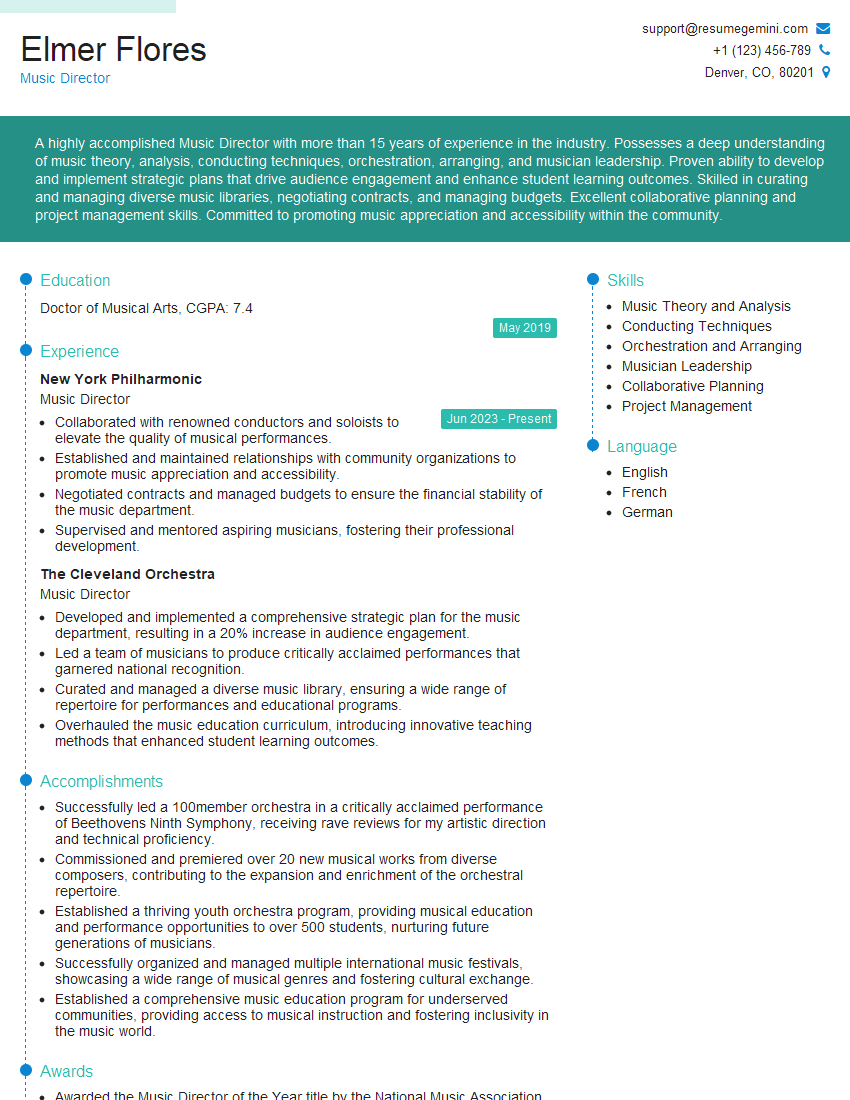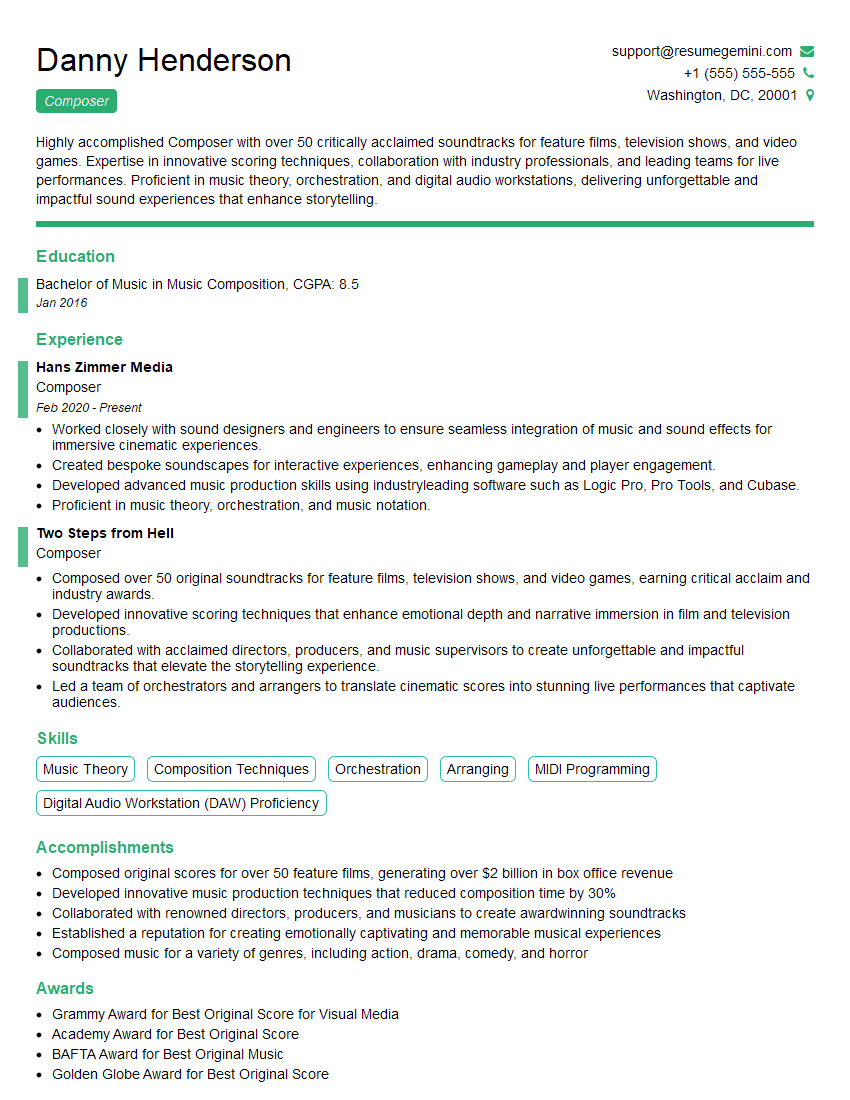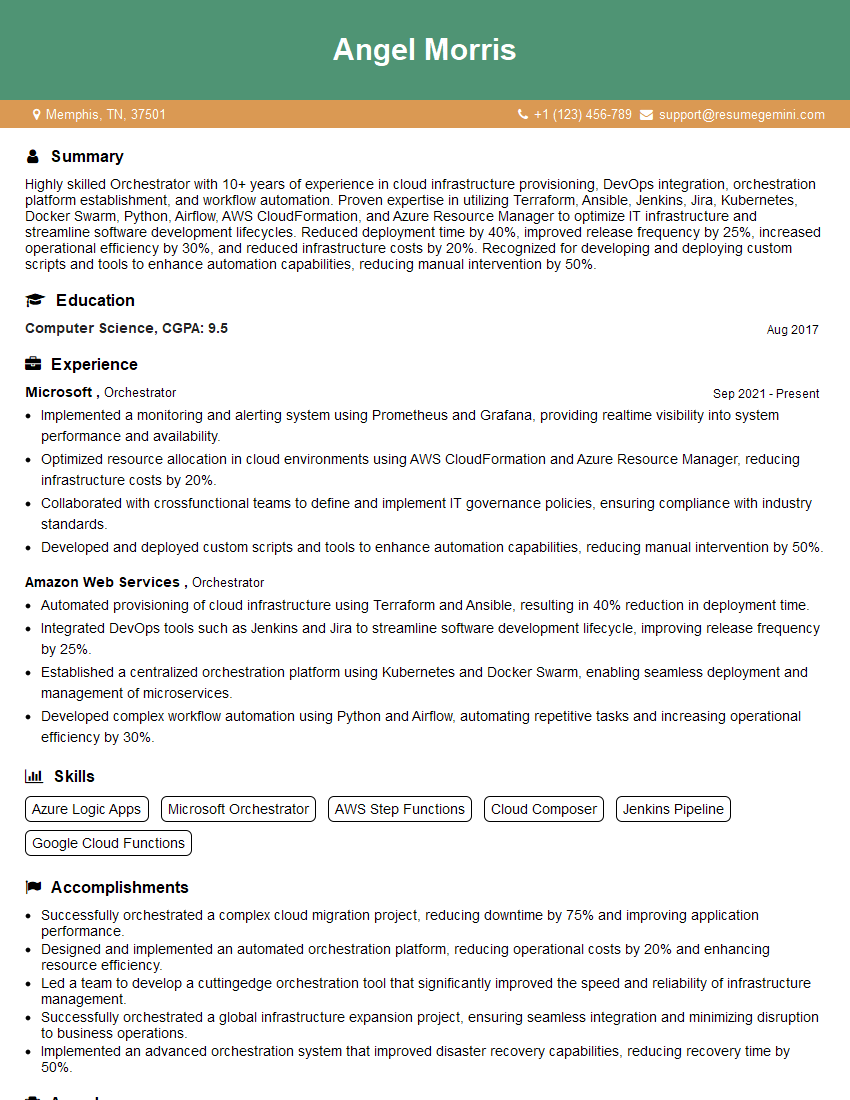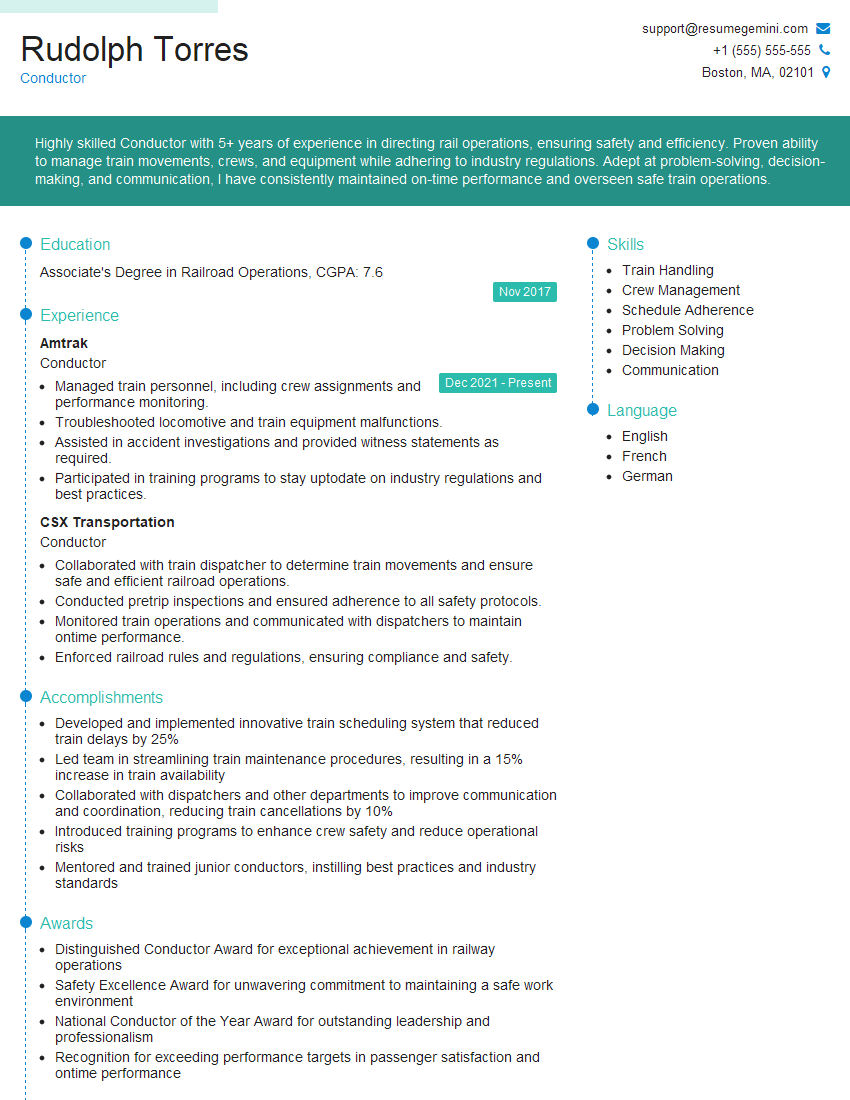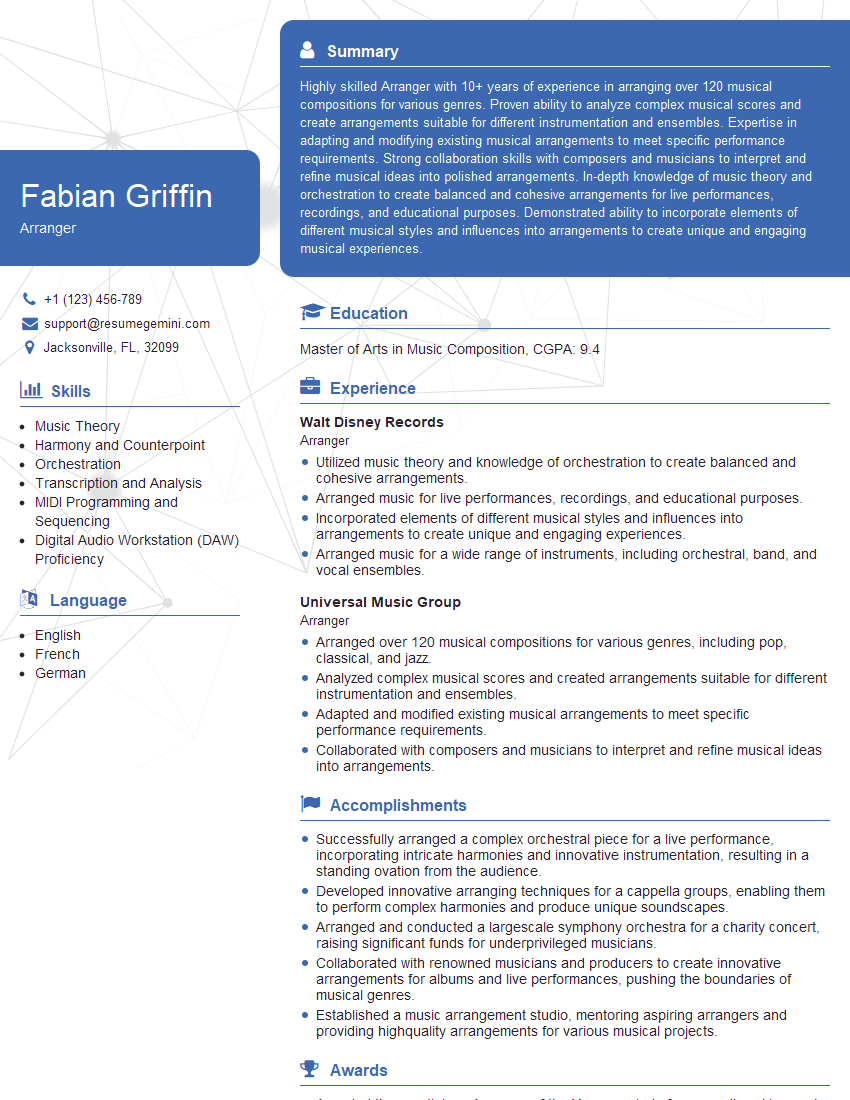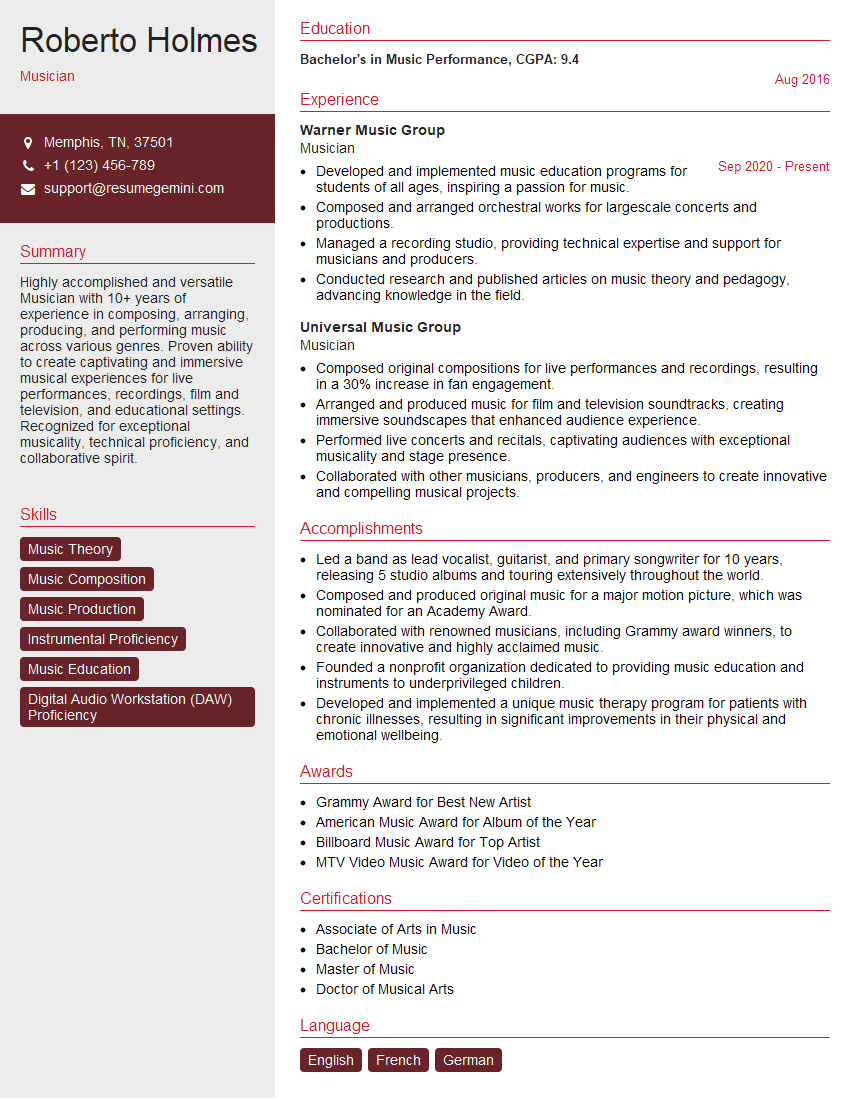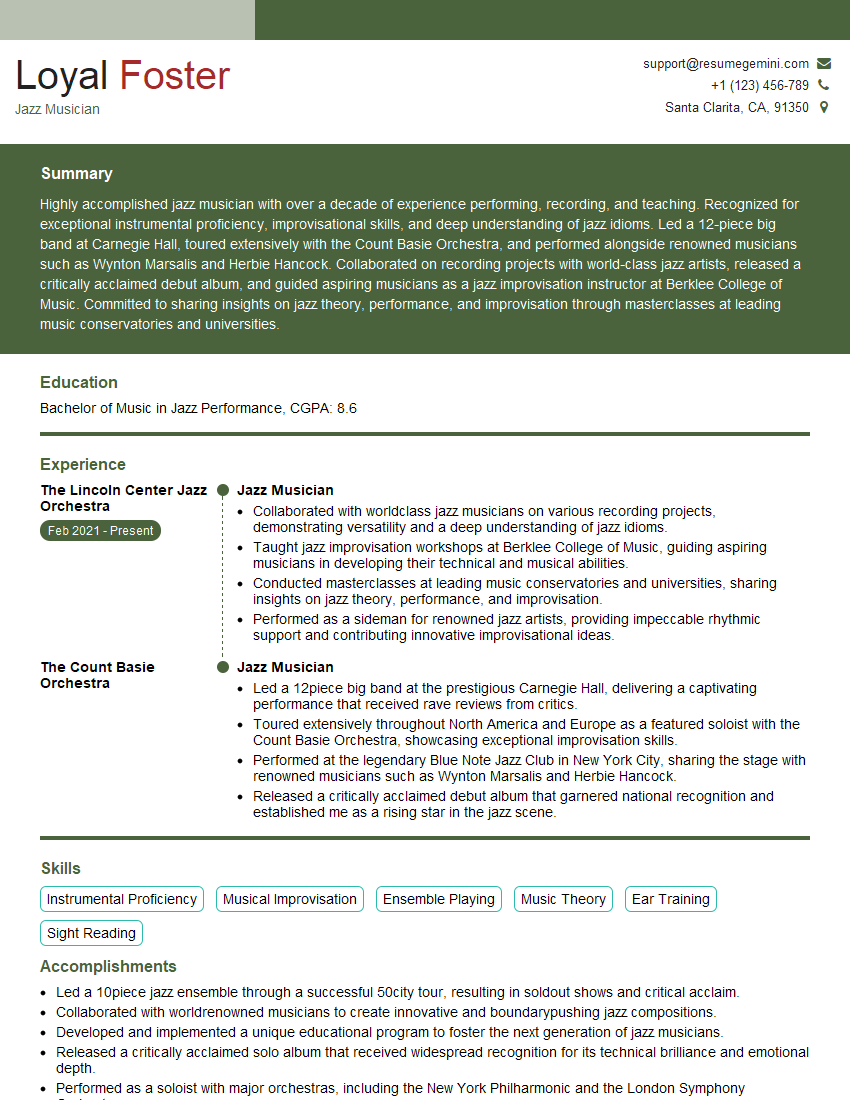Are you ready to stand out in your next interview? Understanding and preparing for Ability to Play in a Variety of Styles and Genres interview questions is a game-changer. In this blog, we’ve compiled key questions and expert advice to help you showcase your skills with confidence and precision. Let’s get started on your journey to acing the interview.
Questions Asked in Ability to Play in a Variety of Styles and Genres Interview
Q 1. Describe your experience playing in different musical genres.
My musical journey has spanned a diverse range of genres, from the intricate harmonies of classical music to the raw energy of rock and roll, the soulful grooves of funk, and the improvisational freedom of jazz. I’ve performed in various ensembles, including orchestras, rock bands, jazz combos, and even folk groups. This exposure has not only broadened my musical understanding but also honed my ability to adapt my playing style to the unique demands of each genre.
For example, my classical training instilled a strong foundation in music theory and technical proficiency, which I later applied to my work in other genres. Playing in a rock band taught me the importance of dynamics and stage presence, while my experience with jazz sharpened my improvisational skills and sense of rhythmic complexity.
Q 2. How do you adapt your playing style to suit various genres?
Adapting my playing style involves a multifaceted approach that considers rhythmic phrasing, harmonic language, and even my physical approach to the instrument. It’s not just about changing techniques; it’s about embodying the genre’s spirit.
- Rhythm: Classical music often emphasizes precise, even rhythms, while jazz embraces syncopation and swing. In rock, strong backbeats and driving tempos are key. I adjust my rhythmic approach to match the genre’s inherent feel.
- Harmony: The harmonic language varies drastically. Classical music might use complex chord progressions and counterpoint, while blues relies on simple, often pentatonic scales. I study the harmonic structures specific to each genre to inform my melodic choices and improvisations.
- Dynamics and Articulation: The intensity and phrasing differ greatly. A delicate classical piece demands subtle nuances, whereas a rock anthem requires power and aggression. I adapt my dynamics and articulation – staccato, legato, etc. – accordingly.
- Instrumentation and Tone: The instrument itself plays a role. My approach to playing a guitar in a jazz context is drastically different than using it in a heavy metal band. I tailor my use of effects, techniques like bending or vibrato, and overall tone to suit the style.
Q 3. What genres are you most proficient in, and what are your strengths within each?
While I’m comfortable across various genres, I possess particular strengths in Classical, Jazz, and Rock.
- Classical: My foundation in classical music provides me with exceptional technical skills, precision, and a deep understanding of musical structure and harmony. My strength lies in my ability to interpret complex scores accurately and expressively.
- Jazz: In jazz, my improvisation skills and understanding of harmony and rhythm shine. I excel at creating spontaneous, melodic lines that complement the harmonic structure and groove of the piece.
- Rock: My experience in rock allows me to create powerful and energetic performances. My ability to blend technical proficiency with raw emotion is a key strength in this area.
It’s important to note that even within these genres, subgenres exist, requiring further specialization and adaptation.
Q 4. Explain how you approach learning a new musical style.
Learning a new musical style is a process of immersion and dedicated study. My approach involves a multi-stage process:
- Immersive Listening: I begin by deeply immersing myself in the genre. This involves listening to a wide range of artists, focusing on their phrasing, rhythm, harmonic choices, and overall style.
- Theoretical Study: I research the theoretical underpinnings of the genre. This includes studying scales, modes, chord progressions, and rhythmic patterns unique to that style.
- Practical Application: I practice playing along with recordings and transcribing solos or sections of music. This allows me to internalize the feel and techniques of the genre.
- Performance and Feedback: I seek opportunities to perform the music in a live setting, or with peers, to receive feedback and further refine my skills.
This iterative approach allows for continuous improvement and a deeper understanding of the nuances of the new style.
Q 5. Have you ever had to quickly learn a new song in a different genre? Describe the process.
Yes, I once had to learn a bluegrass banjo piece for a last-minute fill-in gig. I had minimal bluegrass experience. My process was accelerated, prioritizing efficiency:
- Quick Transcribing: I focused on transcribing the main melody and chord progression as quickly as possible, skipping complex ornamentation initially.
- Simplified Approach: I simplified the rhythm and phrasing, focusing on accuracy over stylistic nuances in the first pass.
- Targeted Practice: I practiced the most challenging sections repeatedly, breaking them down into smaller, manageable chunks.
- Recording and Self-Assessment: I constantly recorded myself to identify areas needing improvement and to track my progress.
While the performance wasn’t perfect, it was sufficiently competent for the gig, demonstrating the adaptability possible with focused effort and a practical approach.
Q 6. How do you maintain your technical skills across diverse genres?
Maintaining technical skills across diverse genres requires consistent and varied practice. I incorporate exercises that address fundamental skills regardless of genre:
- Scales and Arpeggios: Regular practice of scales and arpeggios in various keys and patterns strengthens finger dexterity and improves intonation across different musical contexts.
- Rhythm Training: Exercises focusing on rhythm and syncopation improve timing and rhythmic accuracy, essential for all genres.
- Ear Training: Developing strong ear training skills helps with transcribing, sight-reading, and improvising in different styles.
- Cross-Genre Practice: I intentionally blend techniques from different genres in my practice sessions. For example, I might apply a jazz improvisation technique to a classical piece or a classical articulation style to a rock song.
This holistic approach ensures that my skills remain sharp and transferable across genres, enabling me to seamlessly adapt to new musical challenges.
Q 7. Describe a time you had to improvise in an unfamiliar style.
During a session with a Klezmer band (a genre I wasn’t deeply familiar with), our clarinet player had a sudden illness. I, primarily a guitarist, was asked to fill in on some melodies, despite limited experience with the instrument.
My approach was to rely on my foundational understanding of music theory and rhythm. I listened intently to the existing players, identifying the melodic motifs and harmonic progressions. I simplified my phrasing, focusing on conveying the emotional core of the music rather than perfect technical execution. The result wasn’t a virtuoso performance, but it was a serviceable contribution that kept the music flowing. This experience underscored the importance of adaptable musicality and the value of core musical skills above genre-specific expertise.
Q 8. How do you handle feedback on your performance in different genres?
Feedback is crucial for growth, especially when navigating diverse genres. I approach it systematically. First, I actively listen to understand the critic’s perspective, considering their musical background and potential biases. Is the feedback about technical execution (intonation, rhythm), musical interpretation (phrasing, dynamics), or overall stylistic appropriateness? I then assess the validity of the feedback, separating constructive criticism from subjective opinions. For constructive feedback, I analyze my performance, identifying areas needing improvement. This might involve practicing specific techniques, reviewing relevant musical theory, or seeking further guidance from mentors or colleagues. I document these observations and create a practice plan to address these weaknesses systematically. For subjective opinions, I consider them but focus on maintaining my artistic voice.
For example, feedback on a jazz performance might focus on improvisational fluency and harmonic accuracy, while classical feedback might emphasize precise articulation and adherence to the score. I treat each genre’s feedback uniquely, acknowledging the specific expectations of each style.
Q 9. What are some key differences in musical phrasing and articulation between [Genre A] and [Genre B]?
Let’s compare Classical and Jazz. In Classical music (Genre A), phrasing is often characterized by elegant, legato lines with careful attention to dynamics and articulation markings indicated by the composer. Articulation might include precise staccato, delicate accents, or sustained notes with even bowing or fingerings. In contrast, Jazz (Genre B) encourages more freedom and expressiveness. Phrasing might be characterized by syncopation, rubato (flexible tempo), and a more conversational style. Articulation is more varied and often reflects the improvisational nature of the music – think of the use of scoops, bends, and other expressive techniques in instrumental jazz.
For instance, a Classical sonata might prescribe a specific bowing for a phrase, while a Jazz solo might involve manipulating the pitch of a note during its sustain, something entirely different in phrasing and articulation.
Q 10. How do rhythmic approaches differ across genres, and how do you adapt?
Rhythmic approaches vary wildly across genres. Consider the precise, metrically driven rhythms of Baroque music compared to the complex polyrhythms found in West African music or the swung rhythms of swing jazz. Adapting requires deep understanding of the specific rhythmic conventions of each genre.
In Baroque, accurate note values and rhythmic precision are paramount. In contrast, in Afro-Cuban music, the feel might be driven by a complex interplay between multiple rhythmic layers (polyrhythms), requiring a keen sense of internal rhythmic subdivisions. Swing jazz demands a specific type of rhythmic feel where eighth notes are played unevenly, creating a ‘swing’ effect. My adaptation involves thorough study of the music’s rhythmic structure, listening extensively to examples in that style, and practicing rhythmic exercises tailored to the specific genre. I might use a metronome with subdivisions or work with a drum machine/percussionist to internalize the rhythmic feel. Sometimes, detailed rhythmic analysis (notated or auditive) is essential for mastering the rhythmic complexity.
Q 11. Discuss the importance of musical context when playing in various genres.
Musical context is absolutely crucial. It’s the environment the music lives in – the historical period, the social context, the intended audience. A Bach prelude played in a Baroque concert demands a different approach than the same prelude played in a modern improvisation concert. The harmonic language, rhythmic conventions, and even expressive choices all need to reflect the chosen context. For example, a rock song played in a formal concert hall requires a different approach compared to the same song played in a lively rock club. The performance’s intensity, audience interaction, and even the instrument choices all relate to the context.
Ignoring context leads to inauthentic and jarring performances. I immerse myself in the historical and cultural background of each genre to understand its context and nuance – reading articles, listening to recordings, and seeking insights from scholars in the field.
Q 12. Describe your experience collaborating with musicians from diverse backgrounds.
Collaborating with musicians from diverse backgrounds has been enriching. Working with a flamenco guitarist taught me about the importance of spontaneous interaction and rhythmic interplay. The detailed articulation and precision of a classical violinist helped me refine my own playing technique. Collaborating with a jazz drummer pushed me to develop better improvisation skills and listen more intently to create a unified musical experience. These collaborations involved not only musical skill-sharing but also cultural exchange, deepening my understanding of diverse musical traditions and approaches to music-making. Open communication and mutual respect are essential for successful collaborations.
Learning to appreciate differences in musical styles and cultural approaches broadens my understanding and enhances my versatility as a musician. I always enter such collaborations with a willingness to learn and adapt, fostering a respectful and creatively productive environment.
Q 13. How do you ensure your performance remains authentic while adapting to various styles?
Maintaining authenticity while adapting to diverse styles requires a delicate balance. I achieve this by carefully studying the source material, understanding the genre’s conventions, and developing a deep appreciation for its stylistic nuances. While adopting the techniques and phrasing suitable to the genre, I maintain my own unique musical identity and expressive approach. This isn’t about imitation, but informed interpretation. Think of it as a chef adapting a classic recipe – they use the core ingredients and techniques, but bring their own culinary style and expertise.
For example, I might play a blues song in a style that respects the genre’s history, but still inject my personal phrasing and interpretative flair. I always strive for honesty and integrity in my performance, respecting the source material while presenting it in a fresh and engaging way.
Q 14. How do you choose appropriate instrumentation and arrangement for different genres?
Instrumentation and arrangement are fundamental to effective genre adaptation. The instruments used significantly influence the overall sound and style. A Baroque composition would typically involve period instruments (harpsichord, viol, recorder) while a modern jazz piece might incorporate electric guitar, saxophone, and drums. The arrangement itself determines the harmonic texture, rhythmic complexity, and overall aesthetic. A simple solo piano piece will sound very different from a full orchestral arrangement of the same melody.
My approach to choosing instrumentation begins by considering the historical context and the genre’s conventional instrumentation. Then, based on the specific piece and my creative vision, I may experiment with different instrumental combinations or arrangements to achieve a desired aesthetic effect, always ensuring the arrangement serves the music’s essence and doesn’t overshadow it.
Q 15. How does your understanding of music theory influence your versatility?
A strong grasp of music theory is the bedrock of my versatility. It’s like having a comprehensive toolbox – the more tools you have (understanding of scales, chords, harmony, rhythm, counterpoint etc.), the more diverse the structures you can build. Understanding harmonic progressions, for instance, allows me to seamlessly transition between a bluesy minor key progression in jazz and a major key pop song. Knowing the underlying theoretical framework enables me to quickly adapt to different stylistic conventions. I can easily analyze a piece in any genre and deconstruct its elements—melody, harmony, rhythm—to understand how they create its unique sound. This analytical ability is key to not just playing but also composing and arranging music across genres.
Career Expert Tips:
- Ace those interviews! Prepare effectively by reviewing the Top 50 Most Common Interview Questions on ResumeGemini.
- Navigate your job search with confidence! Explore a wide range of Career Tips on ResumeGemini. Learn about common challenges and recommendations to overcome them.
- Craft the perfect resume! Master the Art of Resume Writing with ResumeGemini’s guide. Showcase your unique qualifications and achievements effectively.
- Don’t miss out on holiday savings! Build your dream resume with ResumeGemini’s ATS optimized templates.
Q 16. What resources or techniques do you use to learn new genres?
Learning new genres is a continuous process. I use a multi-faceted approach. Firstly, I immerse myself in the music. This means extensive listening – critically listening, not just passively. I pay attention to the instrumentation, rhythmic patterns, harmonic structures, and overall sonic textures. Secondly, I actively engage with the music through transcription. Transcribing solos or sections from recordings helps me internalize the nuances of a style. I often use notation software to aid this process. Thirdly, I seek out educational resources: online courses, books, and tutorials specific to the genre. Learning from master musicians in the genre through video analysis or attending workshops is invaluable. For example, if I wanted to learn Flamenco guitar, I’d actively listen to Paco de Lucía, study flamenco rhythms and scales (e.g., *Alzapúa*, *Soleá*), and possibly find a teacher who could guide me through the technical aspects.
Q 17. Describe your process for analyzing and interpreting music from different styles.
Analyzing and interpreting music from different styles involves a systematic approach. First, I identify the key elements: melody, harmony, rhythm, and timbre (the tone color). I analyze the harmonic language – the chords used, their progressions, and their function within the piece. Then I examine the rhythmic structure – the rhythmic motifs, meters, and syncopations. I analyze melodic contours and phrasing. Finally, I look at the instrumentation and how it contributes to the overall texture and sound. For instance, comparing a classical sonata to a reggae song reveals vastly different harmonic structures (classical favoring complex counterpoint and functional harmony, reggae utilizing repetitive chord progressions and offbeat rhythms). By carefully dissecting these elements, I gain a deep understanding of what makes each style unique.
Q 18. How do you manage the challenges of switching between different musical styles during a performance?
Switching between styles during a performance requires meticulous preparation and mental flexibility. I approach this through extensive rehearsal. This includes segmenting the setlist to group similar styles together, allowing for smoother transitions. It’s like switching gears in a car – you wouldn’t go from first to fifth gear instantly. I focus on mindful transitions between pieces, potentially incorporating short instrumental passages or spoken word to bridge the stylistic gap. Mental rehearsal plays a significant role, too. I visualize the performance, focusing on the specific technical and stylistic demands of each piece, so the shift becomes intuitive, rather than a conscious effort. The key is practice and building muscle memory for different stylistic approaches.
Q 19. How do you identify your personal style within a diverse range of genres?
My personal style emerges from a synthesis of the genres I’ve studied and performed. It’s not about choosing one genre and sticking to it, but rather integrating influences from various sources to create a unique sonic identity. Think of it like a culinary fusion – I incorporate elements from different musical ‘cuisines’ to craft my own distinct flavor profile. My personal style manifests in my phrasing, rhythmic approach, and melodic choices. For instance, I might incorporate elements of jazz improvisation within a pop song structure or the rhythmic complexity of Afrobeat into a rock composition. It’s about building my own ‘musical language’ based on what resonates with me across these diverse influences. This is an evolving process, continuously refined through exploration and experience.
Q 20. How do you stay current with trends in various musical genres?
Staying current requires continuous engagement with the musical landscape. I regularly attend live performances, both local and internationally, across diverse genres. I actively listen to new releases, explore streaming services’ genre-specific playlists, and follow artists and bands on social media. Music blogs, podcasts, and online publications provide insights into emerging trends and artists. Engaging with other musicians, attending workshops, and participating in jam sessions provides firsthand experience and exposure to fresh sounds and ideas. I also make a point of reviewing critical articles and reviews, understanding the nuances of critical engagement with different musical styles.
Q 21. What are some of the most significant differences in harmonic language across genres?
The harmonic language varies significantly across genres. For instance, classical music often employs complex tonal structures and functional harmony, with extensive use of modulation and chromaticism. Jazz, on the other hand, heavily utilizes chord extensions, altered dominants, and substitutions, creating a more chromatic and improvisational harmonic palette. Pop music tends to rely on simpler, often diatonic progressions, often emphasizing repetition and strong rhythmic drive. In contrast, genres like traditional folk music may feature modal harmonies with less emphasis on functional harmony. Understanding these core differences is crucial for a versatile musician; it’s not just about knowing chords, but also understanding the context in which they’re used and the cultural implications of those choices.
Q 22. Explain the importance of dynamic range and its application across genres.
Dynamic range, in music, refers to the difference in volume between the loudest and softest parts of a piece. It’s crucial because it allows for expression, emotional depth, and a more engaging listening experience. A piece with a wide dynamic range can build tension and release, create contrast, and tell a story through subtle shifts in volume. Think of a gentle lullaby gradually swelling to a powerful crescendo – that’s dynamic range in action.
- Classical Music: Classical composers like Beethoven utilized dramatic dynamic shifts to create powerful emotional impact. Consider the famous opening of his Fifth Symphony – the iconic four-note motif’s sudden, forceful arrival after a period of silence is a masterful display of dynamic range.
- Jazz: In jazz, dynamic range is used to create subtle nuances and build solos effectively. A jazz pianist might start softly, gradually increasing intensity as the solo progresses, then pulling back for a quieter, more reflective section.
- Pop Music: Even in pop, where dynamics may be less extreme, contrast is still important. A pop song might use a quiet verse to build anticipation before a powerful chorus, or utilize subtle dynamic shifts within the verses themselves to maintain interest.
- Metal Music: In extreme metal, the dynamic range might be compressed, but the contrast between quiet passages and intensely loud sections is vital to creating a specific atmosphere and impact.
Mastering dynamic range involves careful control of volume, articulation, and phrasing. It’s a skill developed through practice and a deep understanding of musical expression.
Q 23. Discuss your experience with musical transcription across different genres.
Musical transcription is a core skill I’ve honed over years of practice across various genres. It involves listening to a piece and accurately writing down the notes, rhythms, and harmonies. The process differs slightly depending on the genre:
- Classical Music: Classical transcription often involves detailed notation, including dynamics, articulation markings, and sometimes even performance directions. I’ve transcribed numerous piano sonatas, requiring a high level of accuracy and attention to detail.
- Jazz: Jazz transcription presents unique challenges, particularly regarding improvisation. Capturing the nuances of a jazz solo, including the rhythmic variations and subtle melodic inflections, requires focused listening and a deep understanding of jazz harmony and improvisation techniques. I’ve transcribed solos by legendary musicians, learning valuable insights into their improvisational styles.
- Folk Music: Transcribing folk music often involves understanding the modal characteristics and ornamentation typical of the genre. It can also involve documenting unique playing techniques and instrumentations.
- Pop Music: Pop transcription often focuses on the arrangement and structure of the song, including vocal melodies, instrumental parts, and chord progressions.
My approach always involves multiple listens, breaking down complex passages into smaller sections, and using music notation software to accurately capture the music.
Q 24. How do you approach learning and applying the unique techniques of various genres?
Learning a new genre involves a multifaceted approach: immersion, analysis, and practice. I begin by immersing myself in the genre, listening to a wide range of artists and performances. I analyze the music’s structure, harmony, rhythm, and characteristic techniques. This analytical stage is crucial to identifying the unique elements of the style. Finally, I practice applying the techniques I’ve learned, focusing on replicating characteristic rhythms, melodies, and harmonic progressions.
- Example: When learning Flamenco guitar, I focused on practicing rasgueado (a strumming technique), alzapúa (a plucking technique), and the specific rhythmic patterns that define the genre. I listened extensively to master Flamenco guitarists, studying their phrasing and emotional expression.
I believe that active listening, coupled with dedicated practice and a willingness to experiment, is key to mastering new genres. The process is iterative, involving continuous refinement of skills and understanding.
Q 25. Describe a time you were challenged to play a style outside of your comfort zone.
I was once asked to perform a set of Appalachian folk music on the banjo, an instrument I had very little experience with. My background primarily lies in classical piano and jazz improvisation. The challenge wasn’t just the unfamiliar instrument, but also the stylistic nuances of Appalachian folk music – its distinct rhythms, melodic phrasing, and use of open tunings.
My approach was to break down the task into smaller, manageable steps. I began with learning basic banjo techniques, focusing on fingerpicking patterns and open tunings. Then, I transcribed a few simple Appalachian tunes, carefully studying their rhythmic and melodic structures. Through dedicated practice and seeking guidance from experienced banjo players, I was able to deliver a performance that, while not perfect, showcased a genuine attempt to engage with the genre’s unique qualities.
Q 26. How do you adapt your stage presence to different musical contexts?
Adapting stage presence hinges on understanding the context and expectations of the audience. A quiet, intimate performance in a small jazz club demands a different approach than a high-energy rock concert.
- Classical: A classical performance often involves a formal and reserved demeanor, focusing on conveying the emotion of the music through precise playing and subtle body language.
- Jazz: A jazz performance is often more interactive and spontaneous, with more freedom for improvisation and expressive gestures.
- Rock: A rock performance can be highly energetic, involving dynamic movements and audience engagement.
I adapt my stage presence by observing the audience’s response, adjusting my energy level and interaction accordingly. The goal is always to create a connection with the audience while remaining authentic to the music’s style and my own personality.
Q 27. How do you maintain musical integrity while blending various styles in a single piece?
Maintaining musical integrity when blending styles requires careful consideration of harmonic and rhythmic relationships. It’s about finding common ground between seemingly disparate genres. The key is not simply juxtaposing elements but integrating them seamlessly.
For instance, incorporating elements of flamenco into a jazz composition might involve using flamenco rhythms and melodic motifs within a jazz harmonic structure. The resulting piece would maintain the core elements of both genres but create something unique and coherent. It’s crucial to choose elements that complement each other rather than clash, ensuring a smooth and natural flow.
This requires a deep understanding of the harmonic and rhythmic underpinnings of each genre and the ability to creatively connect those elements. It’s a process of experimentation and refinement, striving for a balance between innovation and respect for the musical traditions being blended.
Q 28. Describe your approach to incorporating elements of different genres into your original compositions.
When incorporating different genres into my original compositions, I often start with a core idea or feeling. I might begin with a specific rhythmic pattern from one genre, then build a harmonic structure informed by another. For example, I might start with a driving Afrobeat rhythm and then layer a melancholic melody inspired by Irish folk music, creating a unique blend of cultures and sounds.
The process involves experimentation and improvisation. I might record various musical ideas, then arrange and refine them, focusing on creating a unified and coherent whole. The goal isn’t to simply combine elements but to create something new and original through a fusion of diverse musical styles. The resulting piece should reflect a cohesive vision, despite the incorporation of elements from various genres.
Key Topics to Learn for Ability to Play in a Variety of Styles and Genres Interview
- Musicality and Interpretation: Understanding how to adapt your playing style to convey the emotion and character of different genres. This includes phrasing, dynamics, articulation, and rhythmic nuances.
- Genre-Specific Techniques: Mastering the technical skills required for various styles. This might involve exploring different strumming patterns for folk, specific rhythmic approaches for jazz, or advanced fingerpicking techniques for classical.
- Harmonic and Theoretical Understanding: Demonstrating knowledge of chord progressions, scales, and modes relevant to different genres. Be prepared to discuss how these theoretical elements contribute to the overall sound and feel of a piece.
- Improvisation and Creativity: Showcasing your ability to improvise within different stylistic frameworks. This includes understanding melodic, harmonic, and rhythmic improvisation techniques specific to various genres.
- Aural Skills and Transposition: Demonstrating the ability to quickly learn and adapt to new musical material across diverse genres. This includes recognizing melodies, harmonies, and rhythms by ear, and transposing music into different keys.
- Ensemble Playing and Collaboration: Highlighting your experience and skills in playing with others, adapting your style to complement different musicians and musical styles within a group setting.
- Problem-Solving and Adaptability: Being able to troubleshoot technical challenges and adapt your performance on the fly to suit different musical contexts and potential unforeseen issues.
Next Steps
Mastering the ability to play in a variety of styles and genres is crucial for career advancement in the music industry. It opens doors to diverse opportunities, showcasing your versatility and adaptability as a musician. To enhance your job prospects, focus on building an ATS-friendly resume that highlights your skills and experience effectively. ResumeGemini is a trusted resource to help you craft a professional and impactful resume that showcases your unique abilities. Examples of resumes tailored to highlight “Ability to Play in a Variety of Styles and Genres” are available to help you get started. Make your skills shine!
Explore more articles
Users Rating of Our Blogs
Share Your Experience
We value your feedback! Please rate our content and share your thoughts (optional).
What Readers Say About Our Blog
Hello,
We found issues with your domain’s email setup that may be sending your messages to spam or blocking them completely. InboxShield Mini shows you how to fix it in minutes — no tech skills required.
Scan your domain now for details: https://inboxshield-mini.com/
— Adam @ InboxShield Mini
Reply STOP to unsubscribe
Hi, are you owner of interviewgemini.com? What if I told you I could help you find extra time in your schedule, reconnect with leads you didn’t even realize you missed, and bring in more “I want to work with you” conversations, without increasing your ad spend or hiring a full-time employee?
All with a flexible, budget-friendly service that could easily pay for itself. Sounds good?
Would it be nice to jump on a quick 10-minute call so I can show you exactly how we make this work?
Best,
Hapei
Marketing Director
Hey, I know you’re the owner of interviewgemini.com. I’ll be quick.
Fundraising for your business is tough and time-consuming. We make it easier by guaranteeing two private investor meetings each month, for six months. No demos, no pitch events – just direct introductions to active investors matched to your startup.
If youR17;re raising, this could help you build real momentum. Want me to send more info?
Hi, I represent an SEO company that specialises in getting you AI citations and higher rankings on Google. I’d like to offer you a 100% free SEO audit for your website. Would you be interested?
Hi, I represent an SEO company that specialises in getting you AI citations and higher rankings on Google. I’d like to offer you a 100% free SEO audit for your website. Would you be interested?
good
